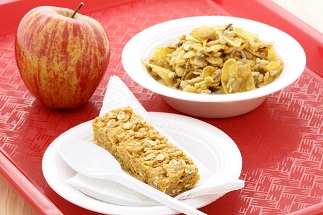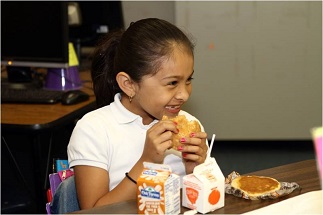The School Breakfast Program remains underutilized: just over half of the low-income children who eat school lunch also eat school breakfast.
The traditional school breakfast program — served before school in the cafeteria — misses too many children and creates unnecessary obstacles for low-income families. Strategies that move breakfast out of the cafeteria and into the classroom are the most successful at overcoming barriers to participation.
Quick Facts: Barriers to School Breakfast Participation
- Rushed morning schedules and non-traditional work hours make arriving to school early to eat breakfast difficult for busy families.
- Buses arrive too late for children to eat breakfast in the cafeteria.
- Social stigma that the breakfast program is only for “poor kids” keeps the children who need the meal most from participating, especially among middle and high school students.
- The reduced-price copay of 30 cents can be a financial barrier for struggling families.
Strategies to Increase School Breakfast Participation

How to Start a Breakfast After the Bell Program
Download the fact sheet
Secondary School Principals’ Breakfast After the Bell Toolkit
Find out more
Make Breakfast Part of the School Day: breakfast in the classroom, “grab and go,” and second chance breakfast.
Learn More
Offer Free Breakfast to All Students
Learn More
Engage Stakeholders
Share findings from our principals surveys
Plan a Nutritious Menu
Watch Our Webinar
Advocate for State School Breakfast Legislation
Learn More
How to Address Implementation Strategies
- Instructional Time
The most common concern that teachers and administrators raise about breakfast in the classroom is that the program will take away from valuable instructional time. In practice, breakfast in the classroom generally takes about 15 minutes for children to eat, and is often done during morning activities, such as announcements, turning in homework or individual reading time so minimal instructional time is lost.
Teachers frequently report that breakfast in the classroom significantly increases their students’ productivity and ability to focus. Less time is spent on distractions such as behavior problems or illnesses caused by hunger. Many schools report fewer visits to the nurse’s office and disciplinary referrals. Moreover, many schools have reported decreased tardiness and absenteeism as students tend to come on time to get their breakfast. As a result, teachers are able to spend more time teaching and less on classroom management issues.
- Pest Control and SanitationPest prevention strategies vary by school but include:
- selecting breakfast menu items with less risk of spillage, especially for elementary schools;
- providing each classroom with basic cleaning supplies and assigning students clean up tasks such as disposing of trash or wiping down desks; and
- placing breakfast trash in a separate trash can or bag to be placed in the hallway and collected promptly after breakfast.
- Menu PlanningMeals served through the School Breakfast Program must meet USDA nutrition guidelines. After deciding to implement an alternative service model, school nutrition departments may have to make significant changes to their traditional breakfast menus. If meals are to be served in the classroom or from kiosks or carts, they should be easy to prepare, serve, and eat in order to limit issues with spills and trash.
Foods that require minimal preparation and work well when served in the classroom include:
- low-sugar cereals
- granola bars
- yogurt
- fresh fruit
- dried fruit
- applesauce
- trail mix
- low fat cheese sticks
- whole-wheat bagels with cream cheese
Serving hot breakfast menu items:
Many schools are able to offer hot options for breakfast as well, either prepared on-site or reheated and served. Schools without on-site kitchens receive pre-made hot foods from a district satellite kitchen or food service company and use hot boxes or other warmers to keep the food at a safe temperature if using a grab and go service model. For breakfast in the classroom, food can be kept warm by transporting them to the classroom in insulated bags. Portable, hand-held items such as breakfast sandwiches and burritos or French toast sticks are easy for students to eat in the classroom. - Engage StakeholdersA successful breakfast program depends upon the collaborative efforts of administrators, principals, teachers, school nutrition staff, custodial staff, and parents. Engaging these groups early on in the process can open up lines of communication and help to address any issues as they arise so they do not create roadblocks later in the implementation process.
Principals and Administrators:
- Provide school breakfast participation rates to principals, as they often are unaware of how few students participate in school breakfast.
- Organize a visit to a school that operates one of the alternative models to show principals and administrators first-hand how it works.
- Ask superintendents to send a letter to principals in their district describing the value of alternative delivery breakfast models or incorporate a presentation about breakfast in the classroom into meetings or trainings.
- Enlist a network of other supportive administrators from nearby districts or other schools in the district to spread the message of how alternative delivery breakfast models increase participation dramatically and support student health and learning.
- Encourage administrators to host a school breakfast contest in the county or district rewarding schools with the greatest increase in participation.
Teachers:
- Enlist teachers to encourage students to participate in the breakfast program and incorporate jobs for students into the breakfast service in the classroom.
- Provide training for teachers to ensure that students are receiving a full reimbursable meal and, if applicable, that teachers are counting and claiming meals properly.
- Inform teachers by having the School Breakfast Program as an in-service day training topic to make sure they know about the academic benefits, barriers to participation, and ways that teachers can help encourage students to participate in breakfast.
- Offer resources to help teachers to develop lessons during the 10–15 minutes that students are eating to ensure that no instructional time is lost. Lessons during breakfast can include a health lesson about the importance of proper nutrition, a math lesson using recipes or nutrition labels, or a science lesson about growing fruits and vegetables.
Custodial Staff:
Engaging custodial staff early in the planning process can help to address any concerns about increased work load or adjusting where and when trash is collected. Continuing to engage them in the implementation process is crucial to make adjustments to make the program run smoother and be sustainable. Once breakfast is moved out of the cafeteria, the custodial staff no longer have to clean the cafeteria after breakfast before preparing for lunch.
Parents:
Parent groups should be engaged early on in the planning process and outreach should be continuous throughout the year. For example:
- Include information about your breakfast in the classroom, grab and go, or second chance breakfast program in the packet of materials that go to parents at the beginning of the school year.
- Invite parents to join students during breakfast in the classroom on a particular day.
- Provide sample breakfast meals and promotional materials at “Back to School Night” or other school events.
- Feature easy-to-access information about breakfast in the classroom on the school website including menus.
- Promote breakfast in the classroom frequently in emails, robo-calls (automated voicemails), on school district radio/TV stations when available, social media outlets such as Facebook and Twitter, and in other communications with parents.
- Mail postcards to families to encourage them to participate.
- Present information on the School Breakfast Program to Parent-Teacher Associations.
- Encourage other school departments to promote the School Breakfast Program.

